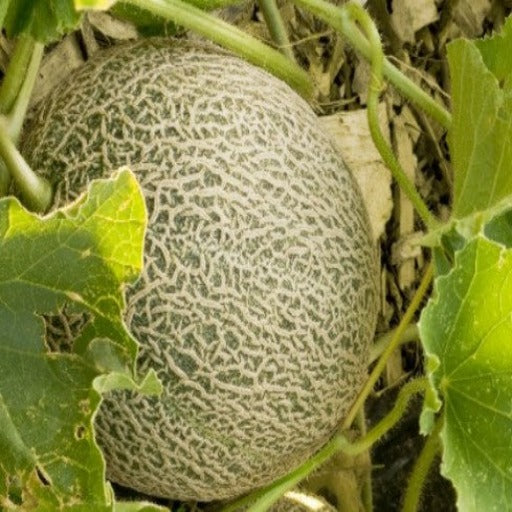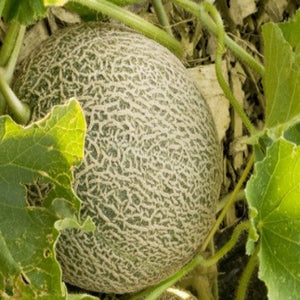- Hardiness Zone: 3-11 Annual
Seed Depth: 1/2–1 inch
Seed Spacing: 24–36 inches
Row Spacing: 5–6 feet
Sunlight: Full sun
Days to Sprout: 7–14 days
Days to Maturity: 80–90 days
Growth Habit: Sprawling Vine
Sunlight: Choose a location that receives full sun for at least 8-10 hours a day. Cantaloupes thrive in warm, sunny conditions.
Soil: Prefers well-drained, sandy, or loamy soil with a pH between 6.0 and 7.5. Amend the soil with compost or well-rotted manure to enhance fertility and drainage. Cantaloupes are heavy feeders, so nutrient-rich soil is essential for optimal growth.
When to Plant: Cantaloupes are warm-season crops that should be planted after the danger of frost has passed and the soil has warmed to at least 70°F (21°C). In cooler climates, you can start seeds indoors 3-4 weeks before the last frost date and transplant them outdoors after the soil has warmed.
Direct Sowing: Sow seeds directly in the garden 1 inch deep in hills spaced 3-4 feet apart. Plant 4-5 seeds per hill, and thin to the 2-3 strongest seedlings once they are a few inches tall.
Transplanting: If starting indoors, transplant seedlings outdoors when they have 2-3 true leaves and the soil has warmed.
Succession Planting: Stagger plantings every 2–3 weeks for a continuous harvest throughout the season.
Watering: Keep the soil consistently moist but not waterlogged. Cantaloupes need plenty of water during the growing season, especially during flowering and fruit development. Water at the base of the plant to avoid wetting the foliage, which can lead to disease. Reduce watering slightly as the fruit begins to ripen to enhance sweetness.
Fertilization: Cantaloupes are heavy feeders. Apply a balanced fertilizer or compost at planting time. Side-dress with a nitrogen-rich fertilizer when the plants are about 6 inches tall, and switch to a phosphorus and potassium-rich fertilizer when the plants start to flower.
Mulching and Weeding: Apply a layer of mulch around the plants to retain soil moisture, suppress weeds, and keep the soil temperature consistent. Mulch also helps protect developing melons from soil contact, which can cause rot. Hand-pull weeds carefully to avoid disturbing the shallow roots of the cantaloupes.
Training and Space Management: Cantaloupes are vining plants that require ample space to spread. If space is limited, consider using trellises to train the vines vertically, but ensure the trellis is sturdy and provide support for the heavy fruits as they develop.
Pest and Disease Management: Cantaloupes can be susceptible to pests such as aphids, cucumber beetles, and squash bugs. Use organic pest control methods like neem oil, insecticidal soap, or hand-picking to manage infestations. Practice crop rotation and ensure good air circulation to prevent fungal diseases like powdery mildew.
When to Harvest: Hale's Best Jumbo Cantaloupes are typically ready to harvest 85-90 days after planting. The best indicator of ripeness is when the fruit easily separates from the vine with a gentle tug, and the skin beneath the netting turns from green to a yellowish color. The melon should also emit a sweet, fragrant aroma.
How to Harvest: Use a sharp knife or pruning shears to cut the cantaloupe from the vine, leaving a short stem attached. Handle the fruit gently to avoid bruising.
Storing Fresh Cantaloupe: Whole cantaloupes can be stored at room temperature for a few days to allow them to fully ripen. Once ripe, store them in the refrigerator and consume within a week. Once cut, cover the cantaloupe pieces and store them in the refrigerator for up to 3-5 days.
Why You’ll Love It
Hale’s Best Jumbo Cantaloupe is known for its classic cantaloupe flavor and reliable performance in home gardens. The fruits grow up to 5 pounds with heavily netted rinds and rich, sweet orange flesh. These vigorous vines tolerate heat and dry conditions, producing fragrant melons that are perfect for slicing, chilling, or blending into refreshing summer treats. A must-grow variety for any melon lover.
Plant Characteristics
Height: Low-growing vine
Growth Habit: Sprawling, heat-loving vines
Fruit Type: Oval, netted rind with deep orange flesh, 3–5 pounds
Days to Maturity: 80–90 days
Hardiness: Warm-season annual
Flavor and Culinary Uses
Flavor: Sweet, juicy, and musky with rich cantaloupe aroma
Culinary Uses: Excellent for fresh slicing, fruit salads, smoothies, and chilled desserts. Enjoy straight from the garden or as a cool picnic treat.
Companion Planting Tips
Good Companions: Corn, radishes, nasturtiums, marigolds, and bush beans
Avoid Planting Near: Other melons or cucumbers that may compete for nutrients or attract the same pests
Bonus Benefit: Vines cover soil to suppress weeds and retain moisture — great for warm, sunny garden spaces
Common Issues and Solutions
Poor Fruit Set: Encourage bees and pollinators by planting flowers nearby or hand-pollinate if needed
Overripe Fruit: Check daily as harvest nears — ripe melons easily slip from the vine and smell sweet
Powdery Mildew: Provide space for airflow and water at the base to avoid damp foliage
Seeds Per Packet
| 1g | Approximately 35 |
| 3g | Approximately 105 |
| 5g | Approximately 175 |
| 10g | Approximately 350 |
Why You’ll Love It
Hale’s Best Jumbo Cantaloupe is known for its classic cantaloupe flavor and reliable performance in home gardens. The fruits grow up to 5 pounds with heavily netted rinds and rich, sweet orange flesh. These vigorous vines tolerate heat and dry conditions, producing fragrant melons that are perfect for slicing, chilling, or blending into refreshing summer treats. A must-grow variety for any melon lover.
Plant Characteristics
Height: Low-growing vine
Growth Habit: Sprawling, heat-loving vines
Fruit Type: Oval, netted rind with deep orange flesh, 3–5 pounds
Days to Maturity: 80–90 days
Hardiness: Warm-season annual
Flavor and Culinary Uses
Flavor: Sweet, juicy, and musky with rich cantaloupe aroma
Culinary Uses: Excellent for fresh slicing, fruit salads, smoothies, and chilled desserts. Enjoy straight from the garden or as a cool picnic treat.
Companion Planting Tips
Good Companions: Corn, radishes, nasturtiums, marigolds, and bush beans
Avoid Planting Near: Other melons or cucumbers that may compete for nutrients or attract the same pests
Bonus Benefit: Vines cover soil to suppress weeds and retain moisture — great for warm, sunny garden spaces
Common Issues and Solutions
Poor Fruit Set: Encourage bees and pollinators by planting flowers nearby or hand-pollinate if needed
Overripe Fruit: Check daily as harvest nears — ripe melons easily slip from the vine and smell sweet
Powdery Mildew: Provide space for airflow and water at the base to avoid damp foliage
Seeds Per Packet
| 1g | Approximately 35 |
| 3g | Approximately 105 |
| 5g | Approximately 175 |
| 10g | Approximately 350 |






Share and get 15% off!
Simply share this product on one of the following social networks and you will unlock 15% off!